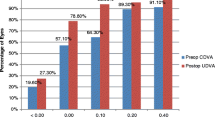Abstract
Purpose
To determine if there was a clinically significant difference in clinical outcomes after toric IOL implantation based on intraoperative aberrometry (IA), where eyes were measured either in the aphakic state only or both the aphakic and pseudophakic states.
Methods
A prospective, randomized, contralateral eye study was performed at one site in Poughkeepsie, NY, USA. Subjects included patients presenting for uncomplicated bilateral cataract surgery eligible for toric lens implantation with regular corneal astigmatism in both eyes whose toric IOL implantation was based on IA. One eye was measured when aphakic and the other when both aphakic and pseudophakic. The primary outcome measure was the magnitude of residual refractive astigmatism. Secondary measures included the percentage of eyes with 0.50D or less of residual refractive astigmatism, the spherical equivalent refraction and the time for IA measurement.
Results
Mean residual refractive astigmatism was not statistically significantly different between groups (0.32D ± 0.46D IA_1 vs. 0.23D ± 0.35D IA_2, p = 0.25), nor was the percentage of eyes with a residual refractive cylinder of 0.50D or less (94% in both groups, p = 1.0). The average time to measure the pseudophakic eye was 3 min, 46 s. Aphakic IA measurements appeared to produce better spherical equivalent refractive results relative to preoperative calculations.
Conclusion
Pseudophakic IA measurements took nearly 4 min per case. Residual refractive astigmatism was not appreciably lower when pseudophakic IA measurements were made after aphakic IA measurements, which suggests aphakic IA measurements alone provide good clinical results with toric IOLs.

Similar content being viewed by others
References
Abulafia A, Koch DD, Wang L et al (2016) New regression formula for toric intraocular lens calculations. J Cataract Refract Surg 42:663–671
Davison JA, Potvin R (2015) Refractive cylinder outcomes after calculating toric intraocular lens cylinder power using total corneal refractive power. Clin Ophthalmol 9:1511–1517
Cionni RJ, Dimalanta R, Breen M, Hamilton C (2018) A large retrospective database analysis comparing outcomes of intraoperative aberrometry with conventional preoperative planning. J Cataract Refract Surg 44:1230–1235
Woodcock MG, Lehmann R, Cionni RJ, Breen M, Scott MC (2016) Intraoperative aberrometry versus standard preoperative biometry and a toric IOL calculator for bilateral toric IOL implantation with a femtosecond laser: one-month results. J Cataract Refract Surg 42:817–825
Tonn B, Klaproth OK, Kohnen T (2014) Anterior surface-based keratometry compared with Scheimpflug tomography-based total corneal astigmatism. Invest Ophthalmol Vis Sci 56:291–298
Holladay JT, Pettit G (2019) Improving toric intraocular lens calculations using total surgically induced astigmatism for a 2.5 mm temporal incision. J Cataract Refract Surg 45:272–283
Hill DC, Sudhakar S, Hill CS et al (2017) Intraoperative aberrometry versus preoperative biometry for intraocular lens power selection in axial myopia. J Cataract Refract Surg 43:505–510
Hatch KM, Woodcock EC, Talamo JH (2015) Intraocular lens power selection and positioning with and without intraoperative aberrometry. J Refract Surg 31:237–242
Solomon JD, Ladas J (2017) Toric outcomes: computer-assisted registration versus intraoperative aberrometry. J Cataract Refract Surg 43:498–504
Lubahn JG, Donaldson KE, Culbertson WW, Yoo SH (2014) Operating times of experienced cataract surgeons beginning femtosecond laser-assisted cataract surgery. J Cataract Refract Surg 40:1773–1776
Roberts HW, Myerscough J, Borsci S, Ni M, O’Brart DPS (2018) Time and motion studies of National Health Service cataract theatre lists to determine strategies to improve efficiency. Br J Ophthalmol 102:1259–1267
Acknowledgements
Sarah Y. Makari, OD is a consultant to Science in Vision who received compensation for writing assistance in preparation of the manuscript.
Author information
Authors and Affiliations
Corresponding author
Ethics declarations
Disclosure
This study was supported with an investigator-initiated study Grant (# 36727981) from Alcon, Forth Worth, USA. Dr. Modi is a consultant to Alcon.
Additional information
Publisher's Note
Springer Nature remains neutral with regard to jurisdictional claims in published maps and institutional affiliations.
Rights and permissions
About this article
Cite this article
Modi, S.S. Clinical outcomes after aphakic versus aphakic/pseudophakic intraoperative aberrometry in cataract surgery with toric IOL implantation. Int Ophthalmol 40, 3251–3257 (2020). https://doi.org/10.1007/s10792-020-01509-y
Received:
Accepted:
Published:
Issue Date:
DOI: https://doi.org/10.1007/s10792-020-01509-y




